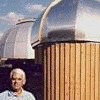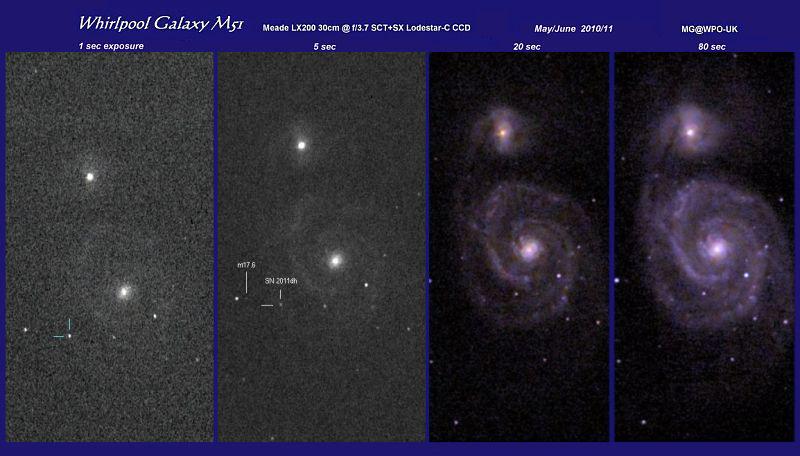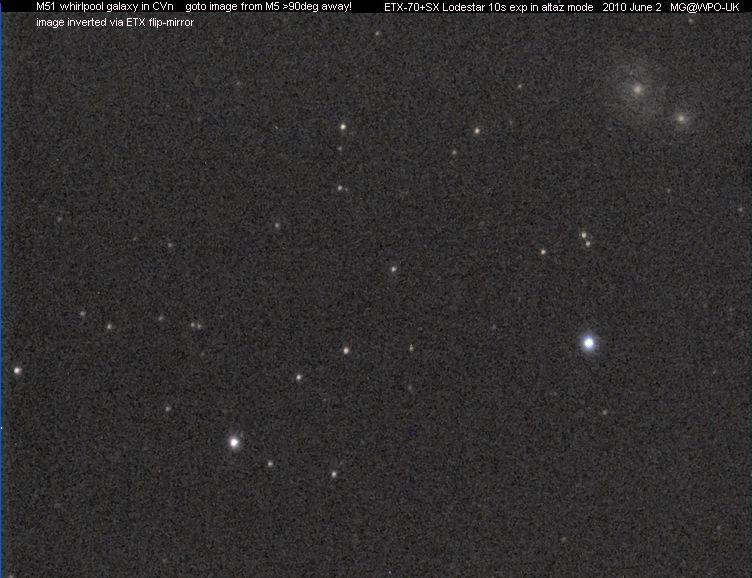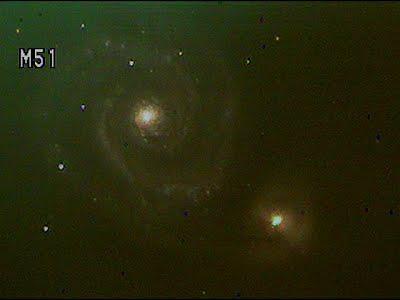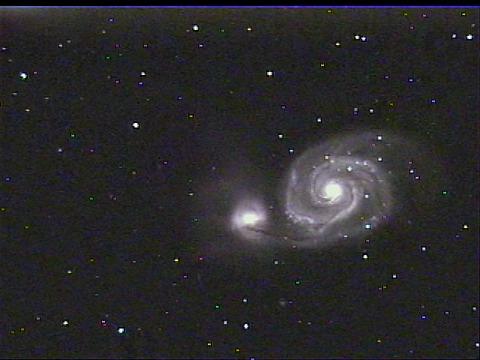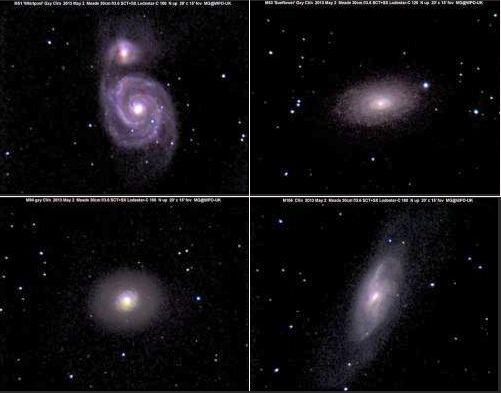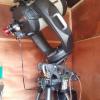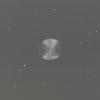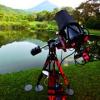
Video integration time equivalent to eye?
#1

Posted 13 April 2013 - 05:07 PM
For example, if using a 12" aperture and eyes may see slight arms from M51. How much integration time would be required from your video cam?
Thanks to all who have tried and share your info!
#2

Posted 14 April 2013 - 03:56 AM
When observing visually, the exit pupil controls image surface brightness and detail seen.
Finally, the amount of sky glow generally impacts the visual image more adversely.
The upshot of these three (more particularly the first two) factors is that the equivalent exposure can vary considerably. And that's not considering such camera specifics such as gain, and the viewing device settings.
#3

Posted 14 April 2013 - 05:31 AM
I've done this in the past eg brief exposure Lodestar DSO pics to mimic the visual impression and my guess for now is ~1s to 5s exposure eg extremely brief in camera terms and longer trumps the visual even via monster amateur scopes - which is why I go this route.I was curious if anyone using Samsung or Lodestar camera has tested how much shutter time or integration time to get equivalent to eye using the same aperture. For example, if using a 12" aperture and eyes may see slight arms from M51. How much integration time would be required from your video cam? Thanks to all who have tried and share your info!
#6

Posted 14 April 2013 - 04:34 PM
Ntecam, thanks a lot for your photos and experience sharing. That was exactly the information that I was looking for!! Your M51 comparison, optics details, and NELM are great demo for others to get some idea to extrapolate what we may get with astrovideo.
Currently, I felt severely limited by my eye, 8" Dob, LP, and from-time-to-time moon light. M51 is my current reference to gauge possible improvement.
The east side of my driveway has NELM of about 3~4. So it seems that the Samsung SCB-2000 will not help me to get your 20-sec M51 with my 8" Dob.
That pushes my decision to the Lodestar C. You have been a great demonstrator of that cam. Can this Lodestar be inserted in focuser just like normal 1.25" eyepiece without any additional adapter?
#7

Posted 14 April 2013 - 05:02 PM
#8

Posted 14 April 2013 - 05:07 PM
Thanks for your interest. Which of my four pics posted does M51 seem like in your EP?Ntecam, thanks a lot for your photos and experience sharing. That was exactly the information that I was looking for!! Your M51 comparison, optics details, and NELM are great demo for others to get some idea to extrapolate what we may get with astrovideo.
Currently, I felt severely limited by my eye, 8" Dob, LP, and from-time-to-time moon light. M51 is my current reference to gauge possible improvement. The east side of my driveway has NELM of about 3~4. So it seems that the Samsung SCB-2000 will not help me to get your 20-sec M51 with my 8" Dob.
That pushes my decision to the Lodestar C. You have been a great demonstrator of that cam. Can this Lodestar be inserted in focuser just like normal 1.25" eyepiece without any additional adapter?
To clarify the Lodestar-C is an uncooled OSC CCD cam [not video-cam] of same dims as a 1-1/4" diam EP so replaces the EP. I use a Meade f/3.3 focal reducer for a 'fast' optical system. The camera is powered and controlled via a single USB2 lead to laptop running SX Lodestar [or other] software for image capture, display, stacking and enhancement etc.
However, whatever camera is used eg video-cam, CCD or DSLR, the scope must IMO be equatorially mounted to track the stars even for a brief 20 sec exp. I don't think your Dob will do that. :o Checkout my set-up and Youtube videos etc via the link below and good luck.
#9

Posted 14 April 2013 - 05:16 PM
@Nytecam
I know that it is a "still imager" and I don't care if that is a video stream with 20-sec refresh time or still image of 20-sec integration time. They serve the same purpose for me.
I plan to use the Meade f/3.3 FR and know that I will need a EQ mount of platform. The camera capability, aperture, integration time, tracking approach, and budget are all needed to be considered for my final solution. I have been pondering it a lot.
#10

Posted 14 April 2013 - 05:19 PM
Jim, that was a nice shot from a NELM 5 sky. What was the integration time?
Max integration for the Samsung - 8.5 sec.
#11

Posted 14 April 2013 - 05:29 PM
#12

Posted 14 April 2013 - 11:02 PM
Of course, the bigger aperture captures fainter stars, too. In this example, 1.5 magnitudes dimmer.
#13

Posted 14 April 2013 - 11:42 PM
Needless to say, the bigger telescopes catch more photons of light over the same exposure time. Hence a 16" will make things brighter than the 4" - that is why you can see the lower magnitude items in the 16"!
Now, in three or so days I will get to try out this video thing on a MallinCam X2 (woo hoo!), but my theory is yes if you point the camera at Vega over the same exposure time, they will look the same in the 16" and 4" (how white/blue/whatever can that big dot get?!?!). But point it at the Whirlpool galaxy, same exposure time, same f/ratio the image scale and brightness will be substantially better on the 16" always. Aperture controls image scale and brightness/light collection.
Of course the 4" will win out if the 16" is located at a cloudy location and the 4" is in a clear location...
#14

Posted 15 April 2013 - 02:10 AM
Just to clarify - in a given brief exposure common in video and my Lodestar imaging, fainter stars will record with a larger aperture irrespective of f/ratio or optical 'speed' eg the "point source" rule. Diffuse [nebulous] objects will record the same density at the same f/ratio irrespective of aperture eg the "diffuse object" rule.Well yes true Glenn except, and as the last sentence points out, the bigger telescope also collects a lot more photons and hence see dimmer items....
Effectively a fast large aperture scope wins in brief exposures and generally has a longer focal length and thus larger image scale to reveal more detail.
#15

Posted 15 April 2013 - 10:52 AM
And just to clarify (for myself as a mental note), aperture dictates amount of light gathering. F/# controls the distribute the light onto sensor. Exit pupil or eye sensitivity variation are now thrown out of the window since we are doing CCD detection with prime focus.
#17

Posted 15 April 2013 - 11:41 AM
Would you please also provide some more info on your shot of M51? I am very interested.
Yea, the intent of the question was to help me to extrapolate what cam or setup needs , kind of educated guess, to reach certain goal. So field data and photos are highly appreciated.
#18

Posted 15 April 2013 - 11:59 AM
#19

Posted 15 April 2013 - 12:32 PM
Is it from MCHP with 56-sec max exposure? And is it from a decent sky?
Thanks!
#20

Posted 15 April 2013 - 01:36 PM
#21

Posted 16 April 2013 - 09:05 AM
I think human eye is very efficient or current sensor technology is not so sensitive yet, as we would like it to be for real live viewing of DSOs (at ~1s exposure duration).
Just image how powerful our eyes could be if they were capable for long exposures like CCD astro cameras.
#22

Posted 16 April 2013 - 07:16 PM
Your test, at only 1/50 second (!), most certainly could not record such a faint phenomenon as the Gegenschein. Which the dark adapted eye does see at a dark site.
I point this out because the result of the test depends sensitively on the subject. A very brief exposure can reveal all the naked eye stars from a light polluted locale, a longer exposure will be required to capture all the naked eye stars at a dark site, a yet longer exposure is needed to equally well represent the brightest nebulae, a still longer exposure is required for the fainter nebulae, and the longest exposures are required to capture the very lowest surface brightness stuff.
It's a continuum. And so the object type and conditions are very important variables to consider.
The eye's huge dynamic range, and its ability to dark adapt, make it impossible to derive just one global equivalence between eye and camera. One has to specify, pretty narrowly, the conditions. Depart much from these, and a new equivalence results.
#23

Posted 05 May 2013 - 07:03 PM
Thanks for your interest. Which of my four pics posted does M51 seem like in your EP?
I realized that I have never answer this question. Compare to Nytecam's photo, two nights before clouds came in I had quick peek through my XT8 when M51 was close to zenith. Still, through my eyepiece, the M51 and its companion were just two cloudy disks without much hint of arms. So it was equivalent and slightly less detailed than the 1-sec integration from Nytecam's 12" and Lodestar. However, that was with a NOT-dark-adapted eye sine I was working with my newly acquired Lodestar. The light from computer really destroyed my dark adaptation.
The good thing now with my XT8 on Atlas, I can get 1-min exposure with good detailed arms structure from M51.
But I made some mistake during saving the image to TIF so I ended up with no picture to show. And the clouds came.
#24

Posted 06 May 2013 - 01:58 AM
Good to hear of your pogress and getting to see on your screen more than possible by eye alone. It's now nearly two decades that I've been doing "electronic assist" deepsky viewing via various CCD cams with the bonus of colour, a record to show others and something to work on on cloudy nights. The only time visual matched my cam was M13 via 16" Dob at a darksite - faint fuzzies forget it - it's cam everytime in the comfort of my LP backyard. Here's some DSOs in CVn from the other nightI realized that I have never answer this question. Compare to Nytecam's photo, two nights before clouds came in I had quick peek through my XT8 when M51 was close to zenith. Still, through my eyepiece, the M51 and its companion were just two cloudy disks without much hint of arms. So it was equivalent and slightly less detailed than the 1-sec integration from Nytecam's 12" and Lodestar. However, that was with a NOT-dark-adapted eye sine I was working with my newly acquired Lodestar. The light from computer really destroyed my dark adaptation. The good thing now with my XT8 on Atlas, I can get 1-min exposure with good detailed arms structure from M51.Thanks for your interest. Which of my four pics posted does M51 seem like in your EP?
But I made some mistake during saving the image to TIF so I ended up with no picture to show. And the clouds came.





